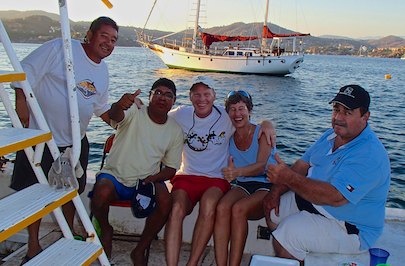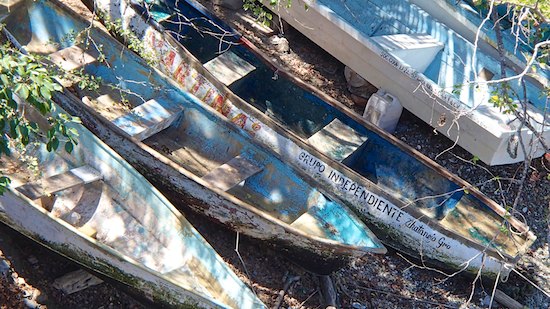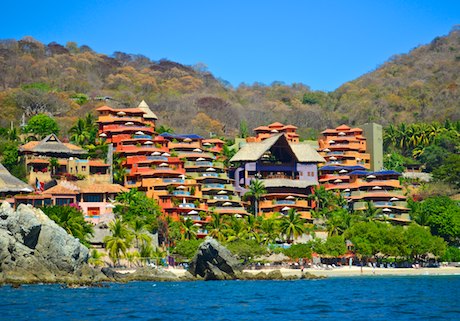
Zihuatanejo bay was busy when we got back.
Late February, 2013 – After our whirlwind inland trip to see Morelia, the migrating monarch butterflies and the magical town of Pátzcuaro, life aboard Groovy resumed very happily. Zihuatanejo is a vacation destination, and tourists were playing around us on the beach and in the water with gusto.

This power yacht has chairs & umbrellas!
One large motor yacht pulled in near us. They had a wonderful back deck with lounge chairs and umbrellas set out. Now that looked like the way to go cruising!

One of our on-shore neighbors.
On our other side, along Playa La Ropa (the bay’s biggest beach), there was a series of palapa beach restaurants. They formed the backdrop to our view as the cruising boats came and went around us. Most boats were returning north, but a few were headed south.

These girls were having so much fun together…
Two boats with families aboard anchored nearby, and we got a huge kick out of watching the kids playing together. Before we left to go cruising, I had assumed that lots of families were “living the dream” aboard sailboats. The cruising magazines publish lots of stories about cruising families, and it led me to believe the ocean was teeming with young families afloat.

Another great sunset off our bow
Not so! In three years of cruising Mexico, we have met eleven boats with kids on board. So it was a real treat to see two boats cruising together with kids the same age. The girls were ten and eleven, and it was heartwarming to watch them jumping in and out of the water from the backs of their boats. They paddle-boarded over to visit each other, and they played all day with the joy and abandon that I remember from my own ten-year-old beach days.

Classic Zihuatanejo scene.

Pretty statue outside Lilly’s restaurant.
In the evenings the sun always set off Groovy‘s bow, silently falling into the sea. Even though it happened every afternoon, we never got tired of it. As the light would turn golden around us, we’d both run for our cameras and get up on the bow to catch the last rays.
Zihuatanejo is a busy little town with an active waterfront. Just like the sunsets, we never got tired of roaming around and watching all the action.

Everyone comes to the fish market…
Some serious fish selling goes on in the fish market, with folks of all kinds, from moms to businessmen, stopping by to pick up a little fish for dinner.

Socorrrrrrrrrito!! (she loves to roll her r’s)
Whenever we stepped on shore from the dinghy landing on the beach, we always heard funny whistling and singing and talking coming from the rafters of one particular building. The noise-maker was Socorrito (more formally, “Socorro”), an 18 year old double yellow headed amazon parrot who lives mostly outside her cage in the little store below Lilly’s restaurant.

One of Francisco’s plates.
She just loves to sing, and her owner would cajole her into performing for us all the time. She was terrific at improv music making. Great long trilling sounds and operatic vibrato came out of her beak, along with lots of Spanish with perfectly rolled r’s. Mark quietly rolled his eyes at the store owner while I carried on lengthy conversations with her.

Francisco shows off a plate.

“La Bamba” on a crutch, a harmonica, a ribbed pipe and a screwdriver!
It is nice to return to a place and find things more or less as you left them the year before, and so it was with our friend the plate painter, Francisco de Alba Castillo. Like last year, he had an array of painted plates and spoons on display, and we admired his new ones each time we walked past.
As with so many street artists, this is his commercial outlet, but he loves to do fine art too. His next project, he told us, is a very large canvas painting that will show the Hand of God, a mighty fist thrust up into a brooding, lightning-filled sky, with blood dripping from the palm. Yikes! I wouldn’t have expected that from a guy who paints pretty seaside images on plates. But Francisco loves drama, and we got a huge charge out of his animated and flamboyant persona whenever we stopped to chat with him.
One of the most engaging things about Mexican seaside towns is the many clever ways people find to entertain and make money from the tourists. We stopped in a beach palapa restaurant one afternoon for a drink, and along with the usual parade of vendors, a fellow came along making the most bizarre music.

We get a tow from a water taxi!
He had rigged up a unique instrument built on a metal crutch. He mounted a harmonica to the top and tie-wrapped a piece of ribbed pipe or tubing to the side. To the bemused smiles of us all, he played a unique rendition of La Bamba. The ragged tune came out of his harmonica while he scraped a large screwdriver against the ribs of the tube for backup rhythm. His performance was worth a few pesos just for sheer inventiveness.
Getting to and from town was an easy mile-long dinghy ride — until the day the prop on our outboard pooped out. We had “spun” the prop back in Huatulco, and Mark had fixed it, but the bolts sheered on one trip across Z-town bay. Getting it fixed was a fun adventure, but when we got back from the repair shop Mark didn’t have the tools to remount the prop on the outboard.

Up the mast on Halcyon
We figured we’d row back to Groovy — good evercise, right? — but it was painfully slow. So Mark hailed a water taxi and we got a tow. Now that was a cool ride!!!

“Fiesta Bamba” gets a face lift.
Boat problems are a normal part of boating, no matter what kind of boat you have. We had anchored next to the elegant ketch Halcyon that was used for daysailing charters. It came and went almost daily, but one afternoon when there was no tour activity, we saw a guy going up the mast to fix something at the top. Luckily the bay wasn’t too rolly that afternoon.

Alberto (left) hosts a fiesta aboard Fiesta Bamba.
The captain of Halcyon, Alberto, was busily getting another tour boat ready for charter. From before dawn until after sunset his crew was busy banging and scraping away on Fiesta Bamba, and we saw the boat slowly come to life. “One more week and we can do tours!” Alberto proudly told us.
He threw a party for all his workers on one of the last days of work, and he invited us to stop over. What a blast! There was enough ceviche and beer to keep a boatload of young, thirsty, hungry and hardworking guys happy, and we joined right in the fun.

Fishermen mend nets under the shade of palm trees.
As with all these seaside towns, the local boat owners are a mix of fishermen and tour operators. The foundation of the local economy comes from the sea. The fishermen mended their nets under the shade of the trees on the beach while the waiters at the restaurants facing the beach capitalized on offering customers the romantic ambiance of dining while overlooking all that authentic fishing activity.
Chatting with a water taxi driver one day, we learned that the pangas the fishermen and water taxis drive are all built in Mazatlán. The newer ones are wonderful, sturdy, 20-odd foot fiberglass boats that cost about 30,000 pesos ($2,400 USD) for the basic hull.

The popular “panga” has a long history.
Water taxis get additional fiberglass shade enclosures added on, and everyone goes for a Yamaha outboard, anywhere from 48 to 75 hp.

Palm tree on Playa Principal, the main beach in Zihuatanejo.
These boats have their origins in canoe shaped boats from eons ago. In his Log from the Sea of Cortez, John Steinbeck describes the 1940’s era boats that paddled out to greeted him in ports along the coast. The panga has come a long way.

Some pangas get a fiberglass shade protection build on top.
Of course, the correctness of the word “panga” is debated. Many Mexicans have told us a real panga doesn’t have a motor, and that these boats are really “lanchas” because they are outboard driven. Some Sea of Cortez fishermen even say that “panga” is a gringo word.
And down in Central America we’ve been told the word “panga” disappears entirely, replaced by “lancha.” Whatever their real name, these boats are everywhere, even 20 miles out to sea.

Fisherman statue in a tiny seaside park.

Mark spots a pretty hibiscus…

Pretty turrets look very inviting!

Colorful resorts cascade down to the bay.
Zihuatanejo is a colorful place, and we enjoyed trying to capture the vibrance of all we saw with our cameras.

Another lovely sunset off Groovy’s bow.
Some of the resorts that cascade down the hillsides have been painted in rich hues of burnt orange, red and yellow, with inviting shapes and pretty shade palapas.
Out in our anchorage we caught yet another pretty sunset off the bow. It’s no wonder people come to this town year after year.
And the funny thing was, with this being our third year in Z-town, we were now among those people too!
But eventually we felt the urge to move on, and we got ready to sail up the coast to Manzanillo’s incomparable Las Hadas Resort.
